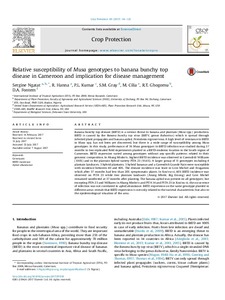| dc.contributor.author | Ngatat, S. |
| dc.contributor.author | Hanna, R. |
| dc.contributor.author | Kumar, P.L. |
| dc.contributor.author | Gray, S.M. |
| dc.contributor.author | Cilia, M. |
| dc.contributor.author | Ghogomu, R.T. |
| dc.contributor.author | Fontem, D.A. |
| dc.date.accessioned | 2019-12-04T11:09:16Z |
| dc.date.available | 2019-12-04T11:09:16Z |
| dc.date.issued | 2017-11 |
| dc.identifier.citation | Ngatat, S., Hanna, R., Kumar, P.L., Gray, S.M., Cilia, M., Ghogomu, R.T. & Fontem, D.A. (2017). Relative susceptibility of Musa genotypes to banana bunchy top disease in Cameroon and implication for disease management. Crop Protection, 101, 116-122. |
| dc.identifier.issn | 0261-2194 |
| dc.identifier.uri | https://hdl.handle.net/20.500.12478/2010 |
| dc.description.abstract | Banana bunchy top disease (BBTD) is a serious threat to banana and plantain (Musa spp.) production. BBTD is caused by the Banana bunchy top virus (BBTV, genus Babuvirus) which is spread through infected plant propagules and banana aphid, Pentalonia nigronervosa. A high level of resistance to BBTD in Musa spp. has not been yet discovered, but there is a wide range of susceptibility among Musa genotypes. In this study, performance of 16 Musa genotypes to BBTD infection was studied during 37 months in two replicated field experiments planted in a BBTD-endemic location in the South region of Cameroon. BBTD expression varied among genotypes without any specific patterns related to their genomic composition. In Abang Minko'o, highest BBTD incidence was observed in Cavendish Williams (100%) and in the plantain hybrid variety PITA 23 (91.6%). A larger group of 11 genotypes including 4 plantain landraces, 3 hybrid plantains, 3 hybrid bananas and a Cavendish Grande Nain were susceptible with incidence between 40 and 80%. The disease incidence was least in Gros Michel and Fougamou which after 37 months had less than 20% symptomatic plants. In Kou'ou-si, 60% BBTD incidence was observed on PITA 23 while two plantain landraces (Asung Mbele, Big Essong) and Gros Michel remained uninfected at 37 months after planting. The banana aphid was present on all genotypes; but excepting PITA 23 and Williams in Abang Minko'o and PITA 14 and PITA 23 in Kou'ou-si, the occurrence of infection was not correlated to aphid abundance. BBTD expression on the same genotype planted in different areas reveals that BBTD expression is not only related to the varietal characteristic but also to the epidemiological situation of the area. |
| dc.format.extent | 166-122 |
| dc.language.iso | en |
| dc.subject | Genotypes |
| dc.subject | Banana Bunchy Top Virus |
| dc.subject | Bananas |
| dc.subject | Food Security |
| dc.subject | Disease Management |
| dc.subject | Dna |
| dc.subject | Bbtd Incidence |
| dc.subject | Aphid Abundance |
| dc.title | Relative susceptibility of Musa genotypes to banana bunchy top disease in Cameroon and implication for disease management |
| dc.type | Journal Article |
| dc.description.version | Peer Review |
| cg.contributor.crp | Roots, Tubers and Bananas |
| cg.contributor.affiliation | International Institute of Tropical Agriculture |
| cg.contributor.affiliation | Université de Dschang |
| cg.contributor.affiliation | United States Department of Agriculture |
| cg.contributor.affiliation | Delaware State University |
| cg.coverage.region | Africa |
| cg.coverage.region | Central Africa |
| cg.coverage.country | Cameroon |
| cg.isijournal | ISI Journal |
| cg.authorship.types | CGIAR and developing country institute |
| cg.iitasubject | Banana |
| cg.iitasubject | Food Security |
| cg.iitasubject | Plantain |
| cg.journal | Crop Protection |
| cg.howpublished | Formally Published |
| cg.accessibilitystatus | Limited Access |
| local.dspaceid | 85745 |
| cg.targetaudience | Scientists |
| cg.identifier.doi | http://dx.doi.org/10.1016/j.cropro.2017.07.018 |

